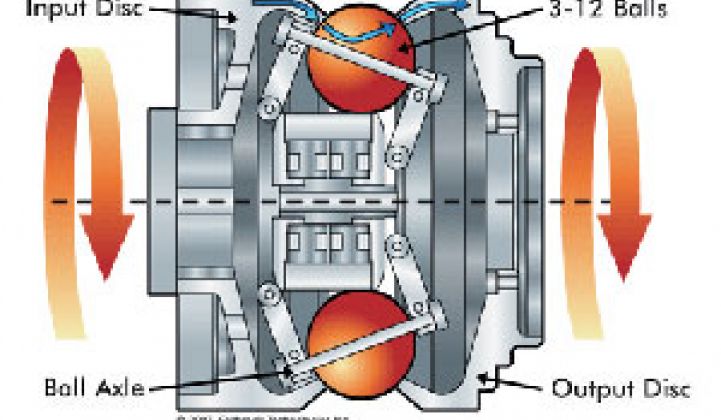Gears are passé.
That's the word from Fallbrook Technologies, a startup that has created a continuously variable planetary (CVP) transmission that it claims could bring substantial gains in efficiencies in wind turbines, cars, scooters and industrial equipment. The company announced today that is has raised $25 million from Robeco, the venture bank of Europe's Rabobank, and Ngen Partners in a second round of funding, to expand production and move into new markets.
In a regular car, one of the company's NuVinci CVPs could improve mileage by 12 percent to 15 percent by keeping pumps and belts tuned to optimum efficiency, said CEO William Klehm, a veteran of Ford. In an electric car, it could improve battery performance by 30 percent, allowing electric car makers to increase the range of their cars or reduce the size of those expensive batteries.
"This device is not made of unobtanium," Klehm added.
Fallbrook has already sold 20,000 NuVinci CVPs to bike makers, who incorporate them into European commuter [pedal] bikes. Soon, it will move into e-bikes and other lightweight electric vehicles.
Viryd, which spun out of Fallbrook, will start selling a version of the NuVinci CVP manufacturers of small wind turbines toward the middle of this year.
A CVP can be thought of as a transmission with an infinite number of gears. In a bike, the power needed to pedal depends on the ratio between the small and large gears: The bigger the difference between those two, the more force it takes to turn the pedals. Because a bike has a fixed number of gears each with a fixed size, you can generally tell when you shift from one combination of gears to the next by the change in force needed to turn the pedal. In the optimal situation, you find a gear that will keep the bike going fast without tiring you out.
A CVP doesn't have gears. Instead the "gears" are sets of rotating and tilting bearings between two disks and the gear ratio is determined by where the two disks make contact on the bearings (see illustration above). If the first disk is near the equator of the bearings and the second disk makes contact with the bearing toward the pole, you're in a very high gear. If the contact point with the first plate stars migrating toward the pole, you've moved toward a lower gear.
Because the two contact points can be virtually anywhere on the smooth surface of the bearings, there is no practical limit to gear ratios. This video also explains it.
In practice, that means that the transmission adjusts to the force and torque on a continuous basis, which in turn allows for optimum power efficiency.
A number of companies have made CVPs for years, but the problem has been durability. Starting in bikes has been an advantage. "When you jump on the pedals, you produce a similar torque as when you start your Honda Accord," he said. "It can handle maximum torque at zero RPM." (Founder Don Miller actually invented the device so he could have a CVD bike.)
The quality of steel has improved steadily as well, making these devices more durable. Improvements in computing power have helped too. Performing the simulations on contact stress created in different ratio combinations would have taken a supercomputer years back.
Components are one of the growing, and in some ways, more promising sectors in green transportation. Although car makers are notoriously conservative, building components requires far less capital than building cars. At the same time, components are not as easily commoditized as fuels. Other green component makers to watch include EcoMotors, Freescale, and Transonic Combustion.
Right now, the main customers are bike manufacturers. The company will take effectively the same part and sell it to makers of e-bikes, scooters and light electric vehicles. A slightly larger version will be sold to wind turbine makers.
The car market will follow after that. Fallbrook does not intend to try to replace conventional transmissions with its CVP. Instead, it will be an accessory transmission that controls ancillary systems. 9.1 percent of the oil imported into the U.S. gets consumed to run automobile air conditioning systems, Klehm said.



